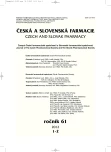Compatibility of phosphates with calcium salts in parenteral nutrition
Authors:
Michal Janů; Marek Vecka 1; Ruta Masteiková 2; Jurga Bernatoniene 3
Authors‘ workplace:
Nemocniční lékárna VFN
; IV. interní klinika 1. LF UK a VFN, Praha
1; Ústav technologie léků, Farmaceutická fakulta, Veterinární a farmaceutická univerzita Brno
2; Katedra technologie léků a sociální farmacie, Farmaceutická fakulta, Litevská univerzita zdravotnických věd, Akademie medicíny, Litva
3
Published in:
Čes. slov. Farm., 2012; 61, 34-39
Category:
Original Articles
Overview
When making prescriptions for total parenteral nutrition (TPN) it is necessary to take into consideration also substitution with calcium and phosphorus. Under some clinical conditions, or in certain groups of patients, it is necessary to supply these substances in high doses with a reduced volume, which due to mutual interactions may be problematic. This experimental paper therefore examined the compatibility of commercially available or individual preparations containing the compounds of calcium and phosphorus. These preparations were examined in a mixture with clinically employed solutions of amino acids or with solutions of glucose. The evaluation was performed by titration until the development of a visible precipitate and also by means of the pharmacopoeial method of evaluation of particles below the level of visibility. Hydrogen phosphate was found to possess a lower compatibility and stability in mixtures containing calcium salts in comparison with dihydrogen phosphate or organic phosphate. Nevertheless, no significant differences were found between dihydrogen phosphate and organic phosphate. The experiment confirmed a better stability of organic calcium salt versus the inorganic one only in the samples containing solutions of amino acids. Of the solutions of amino acids under study, the best stabilizing properties were found in the solutions intended for use in neonatology and paediatrics.
Key words:
parenteral nutrition • calcium • phosphates • compatibility
Sources
1. Chaieb D. R., Chaumeil J-C., Jebnoun S., Khrouf N., Bednili A., Sfar S. Calcium and phosphate compatibility and stability studies in different neonatal parenteral nutrition mixtures. EJHPScience 2006; 12, 35–40.
2. Iacobelli S., Bonsante F., Vintéjoux A., Gouyon J.-B. Standardized parenteral nutrition in preterm infants: Early impact on fluid and electrolyte balance. Neonatology, 2010; 98, 84–90.
3. Food and Drug Administration. Safety alert: hazards of precipitation associated with parenteral nutrition. Am J Hosp Pharm 1994; 51, 1427–1428.
4. Niemiec P. W., Vanderveen T. W. Compatibility considerations in parenteral nutrient solutions. Am J Hosp Pharm 1984; 41, 893–911.
5. Newton D. W., Driscoll D. F. Calcium and phosphate compatibility: revisited again. Am J Health Syst Pharm 2008; 65, 73–80.
6. Zadák Z. Výživa v intenzivní péči. 2. vydání. Praha: Grada Publishing 2008; 212 s.
7. Allwood M. C., Kearney M. C. J. Compatibility and stability of additives in parenteral nutrition admixtures. Nutrition 1998; 14, 697–706.
8. Pertkiewicz M., Cosslett Mühlebach S., Dudrick S. J. Basics in clinical nutrition: Stability of parenteral nutrition admixtures. e-SPEN, Eur. e-J. Clin Nutr Metabol 2009; 4, e117–e119.
9. Parikh M. J., Dumas G., Silvestri A., Bistrian B. R., Driscoll D. F. Physical compatibility of neonatal total parenteral nutrient admixtures containing organic calcium and inorganic phosphate salts. Am J Health-Syst Pharm 2005; 62, 1177–1183.
10. SchrŅder A. M. Total parenteral nutrition – problems in compatibility and stability. EJHPPractice 2008; 14, 65–67.
11. Joy J., Silvestri A. P., Franke R., Bistrian B. R., Nehne J., Newton D. W., Driscoll D. F. Calcium and phosphate compatibility in low-osmolarity parenteral nutrition admixtures intended for peripheral vein administration. J Parenter Enteral Nutr 2010; 34, 46–54.
12. Newton D. W., Driscoll D. F. Chemistry and safety of phosphates injections. Am J Health-Syst Pharm 2008; 65, 1761–1766.
13. Allwood M. C. Compatibility and stability of TPN mixtures in big bag. J Clin Hosp Pharm 1984; 9, 181–198.
14. Braun B. All in one směsi pro totální parenterální výživu. Hradec Králové: Progrestisk 2000; 9–19.
15. Wong J. C., McDougal A. R., Tofan M., Aulakh J., Pineault M., Chessex P. Doubling calcium and phosphate concentration in neonatal parenteral nutrition solutions using monobasic potassium phosphate. J Am Coll Nutr 2006; 25, 70–77.
16. Ronchera-Oms C. L., Jimenez N. V., Peidro J. Stability of parenteral nutrition admixtures containing, organic phosphates. Clin Nutr 1995; 14, 373–380.
17. Bouchoud L., Fonzo-Christe C., Sadeghipour F., Bonnabry P. Maximizing calcium and phosphate content in neonatal parenteral nutrition solutions using organic calcium and phosphate salts. J Parenter EnteralNutr 2010; 34, 542–545.
18. Ybarra J. V. Calcium and phosphate solubility in neonatal parenteral nutrient solutions containing TrophAmine. Nutr Clin Pract 2010; 25, 353–356.
19. Český lékopis 2009. Praha: Grada Publishing 2009.
20. Trissel, L. A., Xu Q. A., Zhang Y., Walter W. V. Use of cysteine hydrochloride injection to increase the solubility of calcium and phosphates in FreAmine III-containing parenteral nutrition solutions. Int J Pharm Compound 2003; 7, 71–77.
21. Shulman R. J., Phillips S. Parenteral nutrition in infants and children. J Pediatr Gastroent Nutr 2003; 36, 587–607.
22. Sobotka L., Allison S. P., Furst P., Meier R., Pertkiewicz M., Soeters P. B. Basics in clinical nutrition. 3rd ed. Prague: Galén 2004; 500 s.
Labels
Pharmacy Clinical pharmacologyArticle was published in
Czech and Slovak Pharmacy

2012 Issue 1-2
Most read in this issue
- The possibilities of innovation of extemporaneous preparation in pharmacies in the Czech Republic
- Compatibility of phosphates with calcium salts in parenteral nutrition
- Metabolomics in research of phytotherapeutics
- Intended pharmacotherapeutical approaches of Alzheimer’s disease therapy
